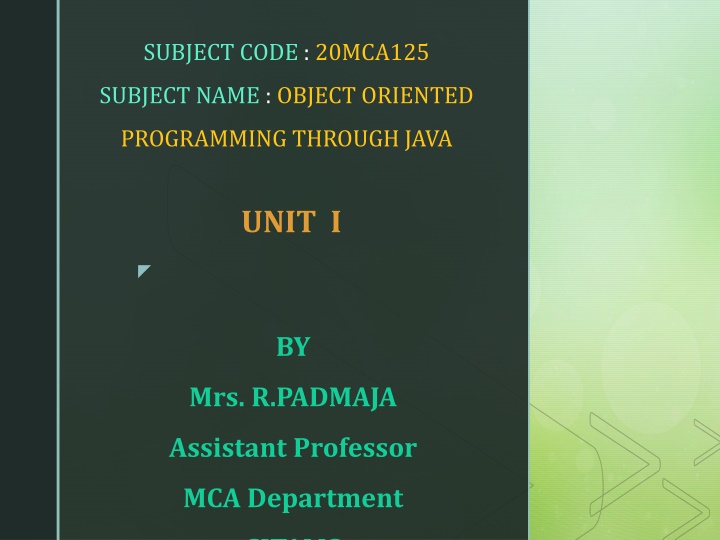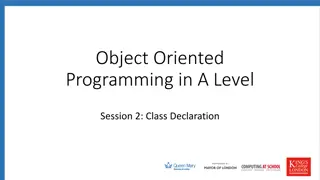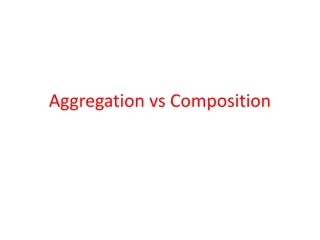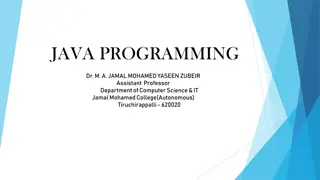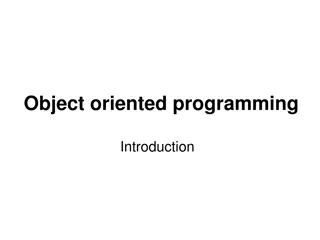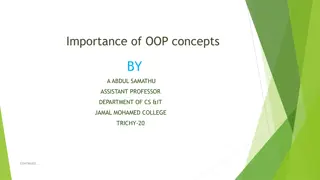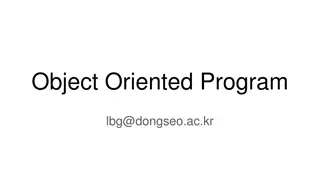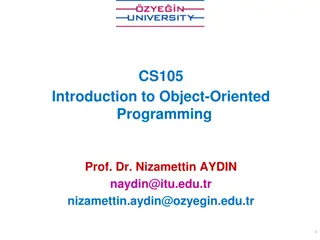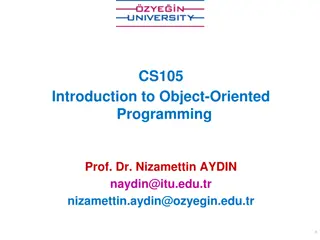Fundamentals of Object Oriented Programming: Introduction and Basic Concepts
This content introduces the fundamentals of Object Oriented Programming through Java, covering topics such as the Object Oriented Paradigm, basic concepts of OOP, Java history, features, and environment. Explore the benefits of OOP, applications, data types, type conversion, control statements, and more. Follow R. Padmaja, Assistant Professor at SITAMS, as she explains the importance of objects in programming. Discover the key features of the Object Oriented Paradigm and how it emphasizes data over procedure in program design.
Download Presentation

Please find below an Image/Link to download the presentation.
The content on the website is provided AS IS for your information and personal use only. It may not be sold, licensed, or shared on other websites without obtaining consent from the author.If you encounter any issues during the download, it is possible that the publisher has removed the file from their server.
You are allowed to download the files provided on this website for personal or commercial use, subject to the condition that they are used lawfully. All files are the property of their respective owners.
The content on the website is provided AS IS for your information and personal use only. It may not be sold, licensed, or shared on other websites without obtaining consent from the author.
E N D
Presentation Transcript
SUBJECT CODE : 20MCA125 SUBJECT NAME : OBJECT ORIENTED PROGRAMMING THROUGH JAVA UNIT I BY Mrs. R.PADMAJA Assistant Professor MCA Department SITAMS
Fundamentals of Object Oriented Programming & Java Evolution 1) 2) 3) Introduction Object Oriented Paradigm Basic concepts of Object Oriented Programming Benefits of OOPs Applications of OOP Java History Java Features Java Environment Constants Data Types Variables Type conversion and Casting Automatic Type Promotion in Expression Arrays Operators and Expressions Control Statements 4) 5) 6) 7) 8) 9) 10) 11) 12) 13) 14) 15) 16) R.Padmaja, Asst.Professor, SITAMS
1. Introduction Programming languages are classified into three types: 1) Un Structured Programming Languages: -- has sequential flow of control -- code is repeated throughout the program 2) Structured Programming Languages: -- has non-sequentially flow of control. --Use of functions allows for re-use of code. 3) Object Oriented Programming : -- Combines data & action together. R.Padmaja, Asst.Professor, SITAMS
2. Object Oriented Paradigm The major objective of object-oriented approach is to eliminate some of the flaws encountered in the procedural approach. OOP treats data as a critical element in the program development and does not allow it to flow freely around the system. It ties data more closely to the functions that operate on it and protects it from unintentional modification by other functions. OOP allows us to decompose a problem into a number of entities called Objects and then build data and functions (known as methods in Java) around these entities. The combination of data and the methods make up an object. R.Padmaja, Asst.Professor, SITAMS
Some of the Features of object-oriented paradigm are: 1) Emphasis is on data rather than procedure. 2) Programs are divided into what are known as Objects. 3) Data Structures are designed such that they characterize the objects. 4) Methods that operate on the data of an object are tied together in the data structure. 5) Data is hidden and cannot be accessed by external functions. 6) Objects may communicate with each other through methods. 7) New data and methods can be easily added wherever necessary . 8) Follow bottom-up approach in program design. R.Padmaja, Asst.Professor, SITAMS
3. Basic Concepts of Object Oriented Programming Object Oriented Programming is a programming concept that works on the principle that objects are the most important part of your program. It allows users create the objects that they want and then create methods to handle those objects. Manipulating these objects to get results is the goal of Object Oriented Programming. Object Oriented Programming popularly known as OOP, is used in a modern programming languages like Java. Object : Any real world entity that has state and behaviour is called as Object .(or) Objects have state and behaviour. Example: Apple, Orange, Bat, Table, etc.. In Java, An Object is an Instance of class. Class : Collection of similar objects is called Class . For Example, Apple, orange, Papaya are grouped into a class called Fruits where as Apple, Table, Bat cannot be grouped as class because they are not similar groups. It is only an logical component not as physical entity. R.Padmaja, Asst.Professor, SITAMS
Inheritance : One object acquires all properties and behaviour of the parent object. It s creating a parent-child relationship between two classes. It offers robust and natural mechanism for organizing and structure of any software. Polymorphism : It refers as one interface and many forms (or) the ability of a variable , object or function to take on multiple forms. Ex:- In English, the verb run has a different meaning if you see it with a laptop , and a foot race . Abstraction : Abstraction is a process of hiding the implementation details from the user. Ex:- while driving a car, you do not have to be concerned with its internal working. Abstraction can be achieved using Abstract Class and Abstract Method in Java. Encapsulation : Encapsulation is a principle of wrapping data (Variables) and code together as a single unit. In this OOPS concept, variables of a class are always hidden other classes. It can only be accessed using the methods of their current classes. from R.Padmaja, Asst.Professor, SITAMS
4. Benefits of OOPs OOP offers several benefits to both the program designer and user. The principal advantages are: OOP offers easy to understand and a clear modular structure for programs. Objects created for Object-Oriented Programs can be reused in other programs. Thus it saves significant development cost. Large programs are difficult to write, but if the development and designing team follow OOPs concept then they can better design with minimum flaws. It also enhances program modularity because every object exists independently. Through inheritance, we can eliminate redundant code and extend the use of existing classes. We can build programs from the standard working modules that communicate with one another, rather than having to start writing the code from scratch. This leads to saving of development time and higher productivity. The principle of data hiding helps the programmer to build secure programs that cannot be invaded by code in other parts of the program. It is possible to map objects in the problem domain to those objects in the program. It is easy to partition the work in a project based on objects. Software complexity can be easily managed. R.Padmaja, Asst.Professor, SITAMS
5. Applications of OOP OOP is one of the programming buzz word today. Some of the applications that OOP includes are: 1) Real-time systems 2) Simulation and modelling 3) Object-oriented databases 4) Hypertext, hypermedia and expertext. 5) AI and expert systems 6) Neural networks and parallel programming 7) Decision support and office automation systems 8) CIM/CAD/CAD systems It is believed that the richness of OOP environment will enable the software industry to improve not only the quality of software systems but also its productivity. R.Padmaja, Asst.Professor, SITAMS
6. Java History In 1990, sun Microsystems has conceived a project to develop software for consumer electronic devices like TVS and VCRs that could be controlled by a remote. This project was called Stealth Project but later its name was changed to Green Project . In January of 1991, Bill Joy, James Gosling, Mike Sheradin, Patrick Naughton and several others met in Colorado to discuss this project. Mike sheradin was to focus on business development, Patrick was on begin work on graphic system , and James Gosling was to identify the proper programming language for this project. Gosling thought C and C++ could be used to develop the project. But the problem he faced with them is that they were system dependent languages and hence could not be used on various processors , which electronic devices use. So he decided to develop new language which is completely system independent. This language was initially called Oak . Later it changed to Java . James gosling and his team members were consume a lot of coffee while preparing this language. They felt that they were able to develop a better language of good quality coffee they consumed. So the coffee has its own role in developing this language and good quality was exported in the entire world from a place called Java Island . Hence they fixed name as Java and the symbol for that language is Coffee cup and saucer. R.Padmaja, Asst.Professor, SITAMS
7. Java Features Features of a language are nothing but the set of services or facilities provided by the language vendors to the industry programmer. Some important features of java are: R.Padmaja, Asst.Professor, SITAMS
a) Simple b) Platform Independent c) Architectural Neutral d) Portable e) Multi Threading f) Distributed g) Networked h) Robust i) Dynamic j) Secured k) Interpreted & High Performed l) Object Oriented R.Padmaja, Asst.Professor, SITAMS
a) Simple According to sun, Java language is simple because It have Rich Set of API (Application Protocol Interface) It have Garbage Collector which is always used to collect un-Referenced memory location for improving performance of a Java program. It has user friendly syntax for developing any applications. It is free from Pointer due to execution time of application is improve . R.Padmaja, Asst.Professor, SITAMS
b) Platform Independent : A language or technology is said to be perform independent if and only if which can run on any available operating systems with respective to its development and compilation. R.Padmaja, Asst.Professor, SITAMS
c) Architectural Neutral : Architecture represents processor. Language or technology is said to be architectural neutral which can run on any available processors in the real world without considering there architecture and vendor with respect to its development and compilation. d) Portable : If any language supports platform independent and architectural neutral then that language is known as portable. Portability= Platform Independent + Architecture e) Multithreaded : Multithreaded means handling multiple tasks simultaneously. Java helps to handle multiple task simultaneously with the help of threads. R.Padmaja, Asst.Professor, SITAMS
f) Distributed : Using this language we can create distributed application. In distributed application multiple client system are depends on multiple server system so that even problem occurred in one server will never be reflected on any client system. R.Padmaja, Asst.Professor, SITAMS
g) Networked : It is mainly design for web based applications. J2EE is used for developing network based applications. h) Robust :Robust means Strong. Java is robust because I. It uses strong memory management. II. There is a lack of pointers that avoids security problems. III. There is automatic garbage collection in java. IV. java has strong exception handling mechanism. i) Object Oriented :Java is an OOP language. Every thing in java is an object . OOP is a methodology or paradigm to design a program using classes and objects. It simplifies the software development and maintenance by providing some concepts: class Inheritance Polymorphism Object Encapsulation Abstraction R.Padmaja, Asst.Professor, SITAMS
8. Java Environment Java Environment include a large number of Development tools and Hundreds of classes and Methods. 1) The Development Tools are part of the system known as Java Development Kit (JDK) and 2) The classes and methods are part of Java Standard Library (JSL) also known as Application Programming Interface. 1. Java Development Kit : The Java Development Kit comes with a collection of tools that are used for developing and running java programs. They include Applet viewer (for viewing java applets) Javac (java compiler) Java (java interpreter) Javap (java dissembler) Javah (for c header files) Javadoc (for creating html documents) Jdb (java debugger) R.Padmaja, Asst.Professor, SITAMS
Tool Description appletviewer Enables us to run java applets java Java Interpreter, runs application javac Java compiler, which translates java source code into byte code javadoc Creates HTML_format documentation from java source code files javah Produces header files for use with native methods javap Java dissembler, which enables us to convert bytecode files into a program description jdb Java debugger, which helps us to find errors in our program R.Padmaja, Asst.Professor, SITAMS
2. API The Java Standard Library (or API) includes hundreds of classes and methods grouped into several functional packages. Most commonly used packages are: Language Support Package : A collection of classes and methods required for implementing basic features of java. Utilities Package : A Collection of classes to provide utility functions such as date and time functions. Networking Package : A collection of classes for communicating with other computers via internet. Input/output Package : A collection of classes required for input/output manipulation. AWT Package : The Abstract Window Tool Kit Package contains classes that implements platform-independent graphical user interface. Applet Package : This include a set of classes that allows us to create Java Applets. R.Padmaja, Asst.Professor, SITAMS
9. Constants Entities that do not change their values in a program are called Constants or Literals. o Java Literals are classified into 5 types: o 1. Integer Literals 2. Floating Point Literals 3. Character Literals 4. Boolean Literals 5. String Literals 1) Integer Literals : A whole number is called an integer. Eg: 25,27 etc are integers Java supports 3 types of integer literals Decimal, Octal, Hexadecimal. 25, 27 are decimal integers Octal stats from 0 and followed by 0 to 7 . Eg: 0.037, 0.08656 are octal integer Hexadecimal start with OX and followed by digits 0 to 9 , A to F. Eg: 0*29, 0*2AB9 are hexadecimal integer literals R.Padmaja, Asst.Professor, SITAMS
2. Floating Point Literals : Numbers with decimal point and fractional values are called floating point literals. They can be expressed in either standard or scientific notation. Standard notation consists of a whole number component followed by a decimal point followed by a fractional component. A Floating point number followed by letter E (or) and a signed integer. Eg: 6.237E-35 stands for 6.237*10^-35. Floating point literals in java defaults to double precision. 3. Boolean literals : In java, Boolean literals take two values false or true. These two values are not related to any numeric value as in C or C++. The Boolean value true is not equal to 1 and false is not value is not equal to 0. 4. Character literals : Single characters in java are called character literals. In java characters belong to 16-bit character set called Unicode. Java characters literals are written within a pair of single quote. Eg: a , z , represent character literals. To represent such characters, java provides a set of character literals called escape sequence. R.Padmaja, Asst.Professor, SITAMS
Escape Sequence Description \ddd Octal character represented in add \uxxx Hexadecimal unicode character \ Single quote \ Double quote \\ Back slash \r Carriage return \n New line \f Form feed \t Tab \b Backspace 5. String Literals : A sequence of characters written within a pair of double quote is called String Literal. Eg: This is String . String Literals are to be started and ended in one line only. R.Padmaja, Asst.Professor, SITAMS
10. Data Types Every variable in java has a data type. Data type specify the size and type of values that can be stored. Data type in java under various categories are shown as: R.Padmaja, Asst.Professor, SITAMS
A. Primitive data types : Primitive data types are whose variables allows us to store only one value but they never allow us to store multiple values of same type. This is a data type whose variables can hold maximum one value at a time. Example: int a; a=10;//valid a=10,20,30;//invalid B. Non Primitive Data Types or Derived Derived data types are those which are developed by programmers by making use of appropriate features of the language. User defined data types related variables allow us to store multiple values either of same type or different type or both. Example: Student s=new Student(); R.Padmaja, Asst.Professor, SITAMS
Java defines some primitive types of data. They are: Integer types Character types Floating type Boolean type 1. Integer Types : This type indicates byte, short, int, long which are for whole-valued signed numbers. Integer Byte Short Int Long The width and ranges of these integer types vary widely as shown in below : Name Long Int Short Byte Width 64 32 16 8 Range -9,223,372,036,854,775,808 TO 9,223,372,036,854,775,807 -2.147,483,648 to 2.147,483,647 -32,768 to 32,767 -128 to 127 R.Padmaja, Asst.Professor, SITAMS
Byte : Smallest integer type is byte. This is signed 8-bit type that has range from -128 to 127 It is declared by byte keyword Short : Short is signed as 16 bit type It has range from -32,768 to 32,767 It is declared by short keyword. Int : The most commonly used type is integer type as int. It is signed as 32 bit type and has range from -2,147,483,648 to 2,147,483,647 Long : long is signed as 64-bit type and is useful for those occasions where as int. The range of long is quite large. This makes it useful when big, whole numbers are needed. R.Padmaja, Asst.Professor, SITAMS
2. Floating Point Types : This group includes float and double which represented numbers in fractional precision. They are two types of floating point types ,float and double, which represents single and double precision numbers Name Width in bits Approximate range Double 64 4.9e-324 to 1.8e+308 Float 32 1.4e-045 to 3.4e+038 3. Characters : In Java, the data type is used to store characters is char. Char in java is not same as C or C++ In C/C++ char is 8 bit type whereas in java char is 16-bit type 4. Boolean Type : Java has a primitive data type called Booleans, for logical values. It can have only one of two possible values true or false. R.Padmaja, Asst.Professor, SITAMS
11. Variables A Variable is an identifier that denote s a storage location used to store a data value . (or) Variables are the names of storage locations. Variable names may consist of alphabets, digits, the underscore and dollar characters. They must not begin with a digit. Uppercase and Lowercase are distinct. This means that the variable Total is not same as total or TOTAL. It should not be a keyword. White space is not allowed. Variable names can be any length. Declaration of Variables : A Variable must be declared before it is used in the program. The general form of declaration of a variable is Type variable1, variable2, variable Variables are separated by commas. A declaration statement must end with a semicolon. Some valid declarations are: Int count; float x, y; R.Padmaja, Asst.Professor, SITAMS
Giving values to Variables : A Variable must be given a value after it has been declared but before it is used in an expression. This can be in two ways: 1. By using an Assignment statement VariableName=value 2. By using a read statement we may also give values to variables interactively through the keyword using the readLine(). Scope of the variable : the scope refers to validity across the java program. The scope of a variable is limited to the block defined within the braces { and } It means a variable cannot be accessed outside the scope (Or) The scope or a particular variable is the range within a program s source code in which that variable is recognized by the compiler. R.Padmaja, Asst.Professor, SITAMS
12. Type Conversion and Casting Assigning a value of one two type to a variable of another type is known as Type Casting. Example: int x=10; byte y=(byte)x; In Java, type casting is classified into two types. Widening Casting (Implicit) : Process of Converting lower data type into higher data type byte --->short --->int --->long ---->float ---->double -----------------------------> Widening Narrowing Casting (Explicitly done) : Process of converting Higher Data type into Lower Data Type double --->float ---->long ----> int ---->short --->byte ------------------------------> Narrowing R.Padmaja, Asst.Professor, SITAMS
Widening or Automatic type conversion : Automatic Type casting take place when, The two types are compatible. The target type is larger than the source type Narrowing or Explicit type Conversion : When you are assigning a larger type value to a variable of smaller type. Then you need to perform explicit type casting. R.Padmaja, Asst.Professor, SITAMS
13. Automatic Type Promotion Expression Java permits mixing of constants and variables of different types in an expression, but during evaluation it adheres to very strict rules of type conversion. If the operands are of different types, the lower type is automatically converted to the higher type before the operation proceeds the result is of the higher type. If byte, short and int variables are used in an a expression, the result is always promoted to int, to avoid overflow. If a single long is used in the expression, the whole expression is promoted to long. If a expression contains a float operand. The entire expression is promoted to float. If any operand id double, result is double. Float to int causes truncation of the fractional part Double to float causes rounding of digits. Long to int causes dropping the excess higher order bits. R.Padmaja, Asst.Professor, SITAMS
14. Arrays An array is a group of continuous or related items that share a common name. For instance, we can define an array name salary to represent a set of salaries of a group of employees. A particular value is indicated by writing a number called index number or subscript in brackets after the array name. One Dimensional Arrays A list of items can be given one variable name using only one subscript and such a variable is called a single-subscripted variable or a one-dimensional array. Declaring Array Variables : Arrays in java may be declared in two forms Form1 type arrayname[ ]; Form2 type[ ] arrayname; R.Padmaja, Asst.Professor, SITAMS
Creating Arrays : you can create an array by using the new operator by using syntax Syntax: arrayname=new type[array_Size]; It creates an array using new type[array_Size] It assigns the reference of the newly created array to the variable arrayname. Declaring , Creating and assigning an array to the variable can be combined in one statement as: type[]=arrayname=new type[array_Size]; (or) type[] arrayname={value0, value 1, ..value k}; Array indices are start from 0 to arrayname.length-1 Two Dimensional Array : It is used to store two dimensional data. It is also used to store data, which contains rows and columns. If the data is linear we can use one dimensional array to work with multi-level data we have to use Multi-Dimensional Array. R.Padmaja, Asst.Professor, SITAMS
Creating Two Dimensional Array : Data_Type[][] Array_Name=new int[Row_Size][Column_Size]; Initialization of Two Dimensional Array : We can initialize the Two Dimensional Array in some ways Example : int[][] Student_Marks = new int[2][3]; int[][] Employees = { {10,20,30}, {15,25,35}, {22,44,66}, {33,55,77} }; R.Padmaja, Asst.Professor, SITAMS
15. OPERATORS AND EXPRESSIONS In java Operators are symbols that are used to perform some operations on the operands. Combination of operands and operators are known as Expressions. Java provides, a rich set of operators to manipulate the variables. There are three types of operators in java. 1. Unary operators 2. Binary operators 3. Ternary operators R.Padmaja, Asst.Professor, SITAMS
1. UNARY OPERATORS: In which we use one operand is called unary operator. It has two types: 1.1 Increment Unary operator 1.2 Decrement Unary operator 1.1 INCREMENT UNAY OPERATOR: This is used to increase the value one by one. It has two types: * Post-fix Increment operator * pre-fix Increment operator 1.1.1 POST-FIX INCREMENT OPERATOR: ++ symbol is used to represent Post-fix Increment operator. This symbol is used after the operand. In this operator, value is first assign to a variable and then incremented the value. EX: int a , b; a=10; b=a++; In the above example first the value of a is assign to the variable b , then increment the value, so the value of b variable is 10 . R.Padmaja, Asst.Professor, SITAMS
1.1.2 PRE-FIX INCREMENT OPERATOR: ++ symbol is used to represent Pre-Fix operator, this symbol is used after the operand. In this operator value is incremented first and then assigned to a variable. EX: int a,b; a=10; b=++a; In the above example first the increment is done then the value of a variable is assigned to the variable b , so the value of b variable is 11 . 1.2 DECREMENT UNARY OPERATOR: - symbol is used to decrease the value by one. It has two types: 1.Post-fix decrement operator 2.pre-fix decrement operator 1.2.1 POST_FIX DECREMENT OPEATOR: - symbol is used to represent post-fix decrement operator, this symbol is used after the operand. In this operator, value is first assigned to a variable and then decrement the value. EX: int a , b; a=10; b=a--; In the above example first the value of a is assign to the variable b , then decrement the value. So the value of b variable is 10 . R.Padmaja, Asst.Professor, SITAMS
1.2.2 PRE-FIX DECREMENT OPERATOR: - Symbol is used to represent the pre-fix decrement operator. This symbol is used after the operand. In this operator, value is decremented first and then decremented value is used in expression. EX: int a,b; a=10; b=--a; In the above example first the value of a is decrement then assign to the variable b . So the value of b variable is 9 . 2. BINARY OPERATOR: In which we use two operand is called Binary operator. Java supports many types of Binary operators: * Assignment operator * Arithmetic operator * Logical operator * Comparison operator 2.1 ASSIGNMENT OPERATOR: This operator is used to assign the value. This symbol = is used to assign the value . EX: int a=12; 2.2 ARITHMETIC OPERATOR: This operator is used to perform mathematical operand. Arithmetic operator are: R.Padmaja, Asst.Professor, SITAMS
Operators Description Use 1. Additional operator ( + ) : Used to add the value of two operand. a+b 2. Subtract operator ( - ) : Used to subtract the value of two operand. a-b 3. Multiply operator ( * ) : Used to multiply the value of two operand. a*b 4. Division operator ( / ) : Used to divide the value of two operand. a/b 5. Modulus operator( % ) : Used returns the remainder of a division operation. a%b R.Padmaja, Asst.Professor, SITAMS
LOGICAL OPERATOR: The logical operator ||(conditional-OR),&&(conditional-AND),!(conditional-NOT) operates on boolean expressions, here s how they work: JAVA LOGICAL OPERATORS R.Padmaja, Asst.Professor, SITAMS
EX: int number1=1,number2=2,number3=9; boolean result; result=(number1>number2)&&(number3>number1) LOGICAL NOT OPERATOR: Logical NOT operator is used to reverse the logical state of its operand. If a condition is true then logical NOT operator will make false. If a condition is false then Logical NOT operator will make true. Then NOT operator is probably the easiest to understand. It is simply the opposite of what the condition says. EX: boolean a=true; if(!a) System.out.println( u r win ); else System.out.println( u r not win ); In above example if not true is asking if the variable a variable is not true, otherwise known as false. If a variable is false, java will displays u r win a variable is not true , so that code will not execute, then the else part is execute shown in output. RELATIONAL OPERATOR: This operator is used to compare the two values, so this operator is also known as comparison operator Conditional symbols and their meanings for comparison operator are below: R.Padmaja, Asst.Professor, SITAMS
EX: int a=10, b=5; if(a>b) System.out.println( a is greater ); else if(a==b) System.out.println( a is not equal to b ); else System.out.prinln( enter 1 to 10 number ); TERNARY OPERATOR: In ternary operator use three operands. It is also called Conditional assignment statement because the value assigned to a variable depends upon a logical expression. SYNTAX: variable=(test expression)?Expression 1: Expression 2 EX: c=(a>b)?a:b: c= (a>b) ? a:b; Test condition ? Expression1 : Expression2; R.Padmaja, Asst.Professor, SITAMS
BITWISE OPERATORS: Java provides 4 bitwise and 3 bit shift operators to perform bit operations. * | Bitwise OR * & Bitwise AND * - Bitwise Complement * ^ Bitwise XOR * << Left shift * >> Right shift * >>> Unsigned Right Shift Bitwise and bit shift operators are used on integral types (byte, short, int and long) to perform bit-level operations. R.Padmaja, Asst.Professor, SITAMS
BITWISE OR: Bitwise OR is a binary operator(operates on two operands). It s denoted by |. The | operator compares corresponding bits of two operands. If their of the bits is 1. If not, it gives 0. EX: 12= 00001100 25= 00011001 Bitwise OR Operation of 12 and 25 00001100 00011001 ---------------- 00011101 =29(In decimal) ---------------- BITWISE AND : Bitwise AND is a binary operator (operates on two operands). It s denoted by &. The & operator compares corresponding bits of two operands. If both bits are 1. If either of the bits is not 1, it gives 0. EX: 12= 00001100 25=00011001 Bit operation of 12 and 25 00001100 00011001 ---------------- 00001000 = 8(in decimal) ---------------- R.Padmaja, Asst.Professor, SITAMS
BITWISE COMPLIMENT : Bitwise compliment is an unary operator(works on only one operand). It is denoted by ~. The ~ operator inverts the bit pattern. It makes every 0 to 1, and every 1 to 0. EX: 35= 00100011(in binary) bitwise complement of 35 ~ 00100011 ------------------ 11011100 = 220(in decimal) -------------------- BITWISE XOR : Bitwise XOR is a binary operator( operates on two operands). It s denoted by ^ . The operator compares corresponding bits of two operands. If corresponding bits are different, It gives 1. If corresponding bits are same, it gives 0. EX: 12=00001100 25=00011001 Bitwise XOR operation of 12 and 25 is: 00001100 1 00011001 ----------------------- 00010101 =21(in decimal) ----------------------- R.Padmaja, Asst.Professor, SITAMS
